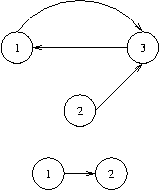Description
Input
Output

Sample Input
3 3 1 3 2 3 3 1 2 1 1 2 0
Sample Output
1 3 2
思路:求强连通后缩点,然后求出度为0 的点就行,出度为0的点在强连通之前可能有多个点的,所以在Tarjan中需要把强连通的那些点记录下来,以便在求出度为0的点使用。
感想:这题WA了十多发,从昨晚做一直到现在都是Wa,搞不明白是什么回事。还以为是边界错了,但是都改了也不对。然后刚才一句一句的看,才发现写代码的时候,在Tarjan算法中把min写成了max,然后LOW数组就错了。靠!!!!!细节搞死人啊,手误就误了一天了!!!!
#include <iostream>
#include <cstdio>
#include <fstream>
#include <algorithm>
#include <cmath>
#include <deque>
#include <vector>
#include <list>
#include <queue>
#include <string>
#include <cstring>
#include <map>
#include <stack>
#include <set>
#define PI acos(-1.0)
#define mem(a,b) memset(a,b,sizeof(a))
#define sca(a) scanf("%d",&a)
#define pri(a) printf("%d\n",a)
#define MM 10002
#define MN 5005
#define INF 168430090
using namespace std;
typedef long long ll;
int n,m,cnt,tem,Count,DFN[MN],LOW[MN],od[MN],vis[MN],suo[MN],q2[MN];
vector<int>q[MN],p[MN];
void tarjan(int u)
{
int j,v;
DFN[u]=LOW[u]=++cnt;
vis[u]=1;
q2[++tem]=u;
for(j=0; j<q[u].size(); j++)
{
v=q[u][j];
if(!DFN[v])
{
tarjan(v);
LOW[u]=min(LOW[u],LOW[v]); //把min写成了max然后导致错了十多发
}
else if(vis[v]&&DFN[v]<LOW[u])
LOW[u]=DFN[v];
}
if(DFN[u]==LOW[u])
{
Count++;
do
{
v=q2[tem--];
vis[v]=0;
p[Count].push_back(v); //连通结点记录下来
suo[v]=Count; //缩点,属于同一个强连通则缩成新的一个结点
}
while(v!=u);
}
}
void solve()
{
int v,i,j;
Count=cnt=tem=0;
mem(DFN,0);
for(i=1; i<=n; i++)
if(!DFN[i]) tarjan(i);
for(i=1; i<=n; i++) //此循环在缩点的基础上,如果需要重新建图就可以重新建图,这里不需要重新建图
for(j=0; j<q[i].size(); j++)
{
v=q[i][j];
if(suo[v]!=suo[i])
od[suo[i]]++; //不属于同一个强连通
}
}
int main()
{
int i,j,u,v,sum;
while(sca(n)&&n)
{
sca(m);
set<int>s;
set<int>::iterator it;
for(i=0; i<=n; i++) q[i].clear(),p[i].clear();
mem(od,0);
mem(LOW,0);
mem(vis,0);
mem(suo,0);
for(i=0; i<m; i++)
{
scanf("%d%d",&u,&v);
q[u].push_back(v);
}
solve();
for(i=1; i<=Count; i++)
if(od[i]==0) //如果出度为0,即从u可以到v,v也可以到u,题目是这个意思,在图论中就是缩点后出度为0
{
for(j=0; j<p[i].size(); j++)
s.insert(p[i][j]); //因为set自动从小到大排序,所以引用
}
for(it=s.begin(),sum=0; it!=s.end(); it++)
{
cout<<*it;
sum++;
if(sum<s.size()) cout<<‘ ‘;
}
cout<<endl;
}
return 0;
}
CUGB图论专场2:The Bottom of a Graph 强连通Tarjan算法
原文:http://blog.csdn.net/u011466175/article/details/19483085